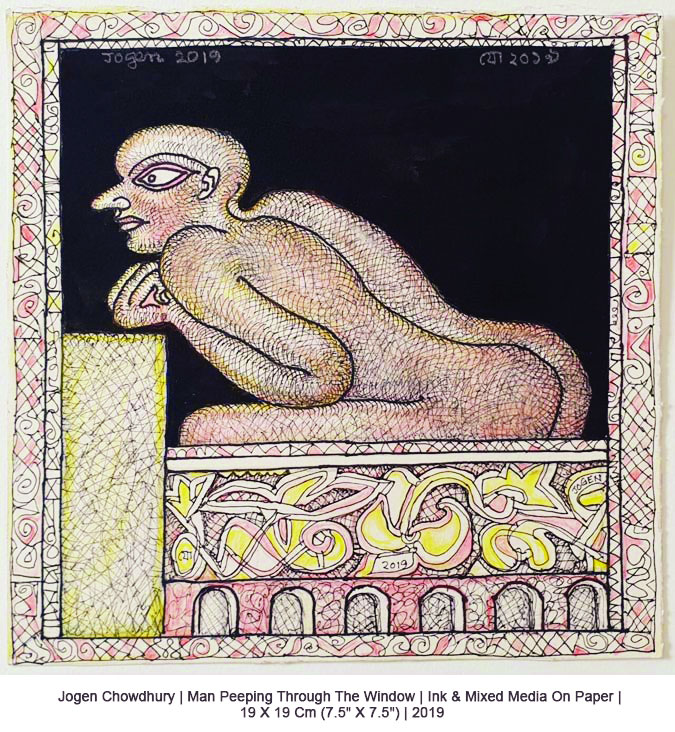The India Art Fair is a rich tapestry that allows you to prime all of your five senses and for the first time creates a tactile and participatory world that engages lensman Pankaj Kumar
As we walk to the India Art Fair, the Palette Art Gallery’s melange of masters throws up a trio of artist Jogen Chowdhury’s drawings that are a treat for tired eyes and stand apart as a corollary of contemporary conversations in the vitality and versatile power of drawings. With humble tools and ink and mixed media on paper, he presents three drawings that are a heady study of anatomical exaggerations and the fascinating felicity of the cross-hatch style that can never grow old. This is what defines Jogenda, the maestro.
Paris in the 1960s
In 2007, when I went to spend a few days at his Shantiniketan home. One chilly winter, he spoke of how a generous scholarship took him to Paris where he was trained at the Ecole Nationale Superieure des Beaux Arts and Atelier 17 of William Hayter, which, at that time, was the finishing school of many talented young Indian artists aspiring to seek rudiments of European techniques. “We had to draw many portraits and sketches of several European models who sat in the studios,” recalled Jogenda. “But I always felt that translating mere realism for the sake of it was not what I wanted. I used to get bored, so I started doing exaggerations in mood and I created a set of pen and ink drawings with those signatures.”
He added, “In later years they became studies of the people I associated with or observed in day to day activities and that is how my cross hatched portraits became part of my sensibility. I think I was yearning for something original and that is the beginning of my journey with such drawings.”
Loose-limbed torsos
Those drawings from the 1960s have come to bearing even today as you look at two portraits of men and one of a bulbous woman. Intriguing perhaps to see that Jogenda is happy creating loose-limbed, bulging torsos of naked evocative men who are by no means young, and also creating a long-haired woman with rotund eyes with thin and knobbly arms that end in long undulating fingers. These two men and the woman are by no means large but their impact is indeed monumental almost as if their flesh has turned into skin that is coarsely tinted and hewn by his pliant pen and ink. The body with deeply grooved furrows ensures a striking attractiveness that emanates a strong and pulsating sensuality.
Patachitras and alpanas in reference
Jogenda is the master of the modernist figure. The manner in which he distorts form with the pensive fluidity of lines is reminiscent of all forms and indices of the ritualistic alpana created on the floors of Bengali homes by gorgeous women with graceful saris. In all the three drawings, Jogenda draws our attention to the limbs and if we look closely, the extremities have a luxuriant as well as languid grace about them. This reminds us of the abundant foliage on rooftops, crevices and corners of villages.
“My work has always been deeply rooted in Indian traditions,” states Jogenda. “You can look at many references but of course the one that comes instantly to mind is that of the patachitras, alpanas and the floral studies that I have done and observed in the past.”
Surrealism
What is evident also is how in the drawing that is a portrait he gives us the limpid language of surrealism. The decorative element is inherent in Jogenda’s style, but for him embellishment has its own flourish, its own lingua franca. It also highlights folk elements. The beauty of these three drawings is the intricate crosshatching that gives an undeniable three-dimensional quality. These drawings are far from beautiful, they have tales to tell and elicit the power of the human hand because despite his age, Jogenda dares to be simple and sophisticated, leaving his lithe, loose lines to do all the talking. The panache and perfection of using pen and ink directly on paper is non pareil. The lines meander across the white surface and as the human forms take shape, we are reminded that drawing is the basis of all art and it is the human hand that empowers and embraces the very spirit of creation.
Writer: Uma Nair
Courtesy: The Pioneer








 OpinionExpress.In
OpinionExpress.In















Comments (0)